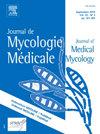Thymol inhibits ergosterol biosynthesis in Nakaseomyces glabratus, but differently from azole antifungals
IF 1.8
4区 医学
Q3 MYCOLOGY
引用次数: 0
Abstract
Introduction
Nakaseomyces glabratus is considered a high priority of attention according to WHO, and also is an important yeast species due to its high rate of intrinsic/acquired resistance against fluconazole. This study aimed at the possible mechanisms of action of thymol, as the promising new antifungal agent, in N. glabratus.
Methods
Thirty previously identified N. glabratus isolates were selected for investigation of the thymol susceptibility pattern. The antifungal susceptibility test was performed according to the Clinical and Laboratory Standards protocol published as M27-A2 document. Likely changes in the expression pattern of genes involved in the ergosterol biosynthesis pathway were assessed by Real-time PCR assay. The ultrastructure characteristics of thymol-treated yeasts and also the possible interactive proteins, as targets for thymol binding, were performed by transmission electron microscopy (TEM) and reverse molecular docking, respectively.
Results
Minimum inhibitory concentrations ranged between 32–128 µg/mL which were statistically significant between the fluconazole-susceptible and fluconazole-resistant yeast group (P<0. 05). TEM observation results showed that thymol led to peripheral vacuole formation which refers to plasma membrane damage and cell membrane separation from the cell wall. Thymol exhibits antifungal activity against N. glabratus by regulating multiple signaling pathways including ergosterol biosynthesis (ERG1) and HOG (high-osmolarity glycerol) MAPK (mitogen-activated protein kinase) pathways. In consistence with the yielded gene expression patterns, docking evaluation findings also revealed the high affinity of thymol with proteins related to the ERG1 gene. Accordingly, thymol's high affinity to chitin synthase and calcineurin subunit B was noteworthy.
Conclusion
Thymol might employ its antifungal effect by involving different pathways comprising ergosterol biosynthesis inhibition but not identical to the azole drugs. It is highly suggested that thymol ruins cell membrane function by decreasing the ergosterol/or chitin content. However, studying more ergosterol biosynthesis-related genes and also the yeast apoptotic responses is highly recommended for future investigations.
百里香酚对裸毛中aseomyces glabratus麦角甾醇的生物合成有抑制作用,但与唑类抗真菌剂不同。
摘要:毛中aseomyces glabratus是世界卫生组织高度重视的酵母,也是一种重要的酵母品种,因为它对氟康唑具有较高的内在/获得性耐药率。本文旨在探讨百里香酚作为一种新型抗真菌药物在毛霉中的作用机制。方法:选取30株已鉴定的秃毛野鼠分离株进行百里香酚的敏感性研究。根据M27-A2文件公布的临床和实验室标准方案进行抗真菌药敏试验。实时荧光定量PCR检测麦角甾醇生物合成途径相关基因表达模式的可能变化。利用透射电镜(TEM)和反向分子对接研究了经百里香酚处理的酵母的超微结构特征以及可能作为百里香酚结合靶点的相互作用蛋白。结果:最低抑菌浓度为32 ~ 128µg/mL,氟康唑敏感酵母组和氟康唑耐药酵母组抑菌浓度差异有统计学意义(p)结论:百里香酚可能通过抑制麦角甾醇生物合成的不同途径发挥抑菌作用,但与唑类药物不同。这表明百里香酚通过降低麦角甾醇/或几丁质含量而破坏细胞膜功能。然而,研究更多麦角甾醇生物合成相关基因以及酵母凋亡反应是未来研究的重要内容。
本文章由计算机程序翻译,如有差异,请以英文原文为准。
求助全文
约1分钟内获得全文
求助全文
来源期刊
CiteScore
5.10
自引率
2.80%
发文量
68
审稿时长
6-12 weeks
期刊介绍:
The Journal de Mycologie Medicale / Journal of Medical Mycology (JMM) publishes in English works dealing with human and animal mycology. The subjects treated are focused in particular on clinical, diagnostic, epidemiological, immunological, medical, pathological, preventive or therapeutic aspects of mycoses. Also covered are basic aspects linked primarily with morphology (electronic and photonic microscopy), physiology, biochemistry, cellular and molecular biology, immunochemistry, genetics, taxonomy or phylogeny of pathogenic or opportunistic fungi and actinomycetes in humans or animals. Studies of natural products showing inhibitory activity against pathogenic fungi cannot be considered without chemical characterization and identification of the compounds responsible for the inhibitory activity.
JMM publishes (guest) editorials, original articles, reviews (and minireviews), case reports, technical notes, letters to the editor and information. Only clinical cases with real originality (new species, new clinical present action, new geographical localization, etc.), and fully documented (identification methods, results, etc.), will be considered.
Under no circumstances does the journal guarantee publication before the editorial board makes its final decision.
The journal is indexed in the main international databases and is accessible worldwide through the ScienceDirect and ClinicalKey platforms.

 求助内容:
求助内容: 应助结果提醒方式:
应助结果提醒方式:


